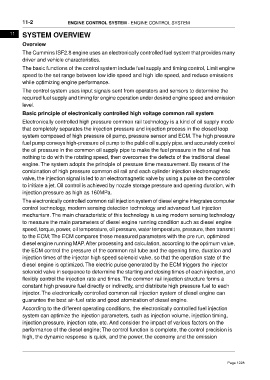Page 1228 - Foton Workshop Manual - Tunland (AT)
P. 1228
11-2 ENGINE CONTROL SYSTEM - ENGINE CONTROL SYSTEM
11 SYSTEM OVERVIEW
Overview
The Cummins ISF2.8 engine uses an electronically controlled fuel system that provides many
driver and vehicle characteristics.
The basic functions of the control system include fuel supply and timing control, Limit engine
speed to the set range between low idle speed and high idle speed, and reduce emissions
while optimizing engine performance.
The control system uses input signals sent from operators and sensors to determine the
required fuel supply and timing for engine operation under desired engine speed and emission
level.
Basic principle of electronically controlled high voltage common rail system
Electronically controlled high pressure common rail technology is a kind of oil supply mode
that completely separates the injection pressure and injection process in the closed loop
system composed of high pressure oil pump, pressure sensor and ECM. The high pressure
fuel pump conveys high-pressure oil pump to the public oil supply pipe. and accurately control
the oil pressure in the common oil supply pipe to make the fuel pressure in the oil rail has
nothing to do with the rotating speed, then overcomes the defects of the traditional diesel
engine. The system adopts the principle of pressure time measurement. By means of the
combination of high pressure common oil rail and each cylinder injection electromagnetic
valve, the injection signal is led to an electromagnetic valve by using a pulse on the controller
to initiate a jet. Oil control is achieved by nozzle storage pressure and opening duration, with
injection pressure as high as 160MPa.
The electronically controlled common rail injection system of diesel engine integrates computer
control technology, modern sensing detection technology and advanced fuel injection
mechanism. The main characteristic of this technology is using modern sensing technology
to measure the main parameters of diesel engine running condition such as diesel engine
speed, torque, power, oil temperature, oil pressure, water temperature, pressure, then transmit
to the ECM; The ECM compares these measured parameters with the pre run, optimized
diesel engine running MAP. After processing and calculation, according to the optimum value,
the ECM control the pressure of the common rail tube and the opening time, duration and
injection times of the injector high speed solenoid valve, so that the operation state of the
diesel engine is optimized. The electric pulse generated by the ECM triggers the injector
solenoid valve in sequence to determine the starting and closing times of each injection, and
flexibly control the injection rate and times. The common rail injection structure forms a
constant high pressure fuel directly or indirectly, and distribute high pressure fuel to each
injector. The electronically controlled common rail injection system of diesel engine can
guarantee the best air-fuel ratio and good atomization of diesel engine.
According to the different operating conditions, the electronically controlled fuel injection
system can optimize the injection parameters, such as injection volume, injection timing,
injection pressure, injection rate, etc. And consider the impact of various factors on the
performance of the diesel engine; The control function is complete, the control precision is
high, the dynamic response is quick, and the power, the economy and the emission
Page 1228

